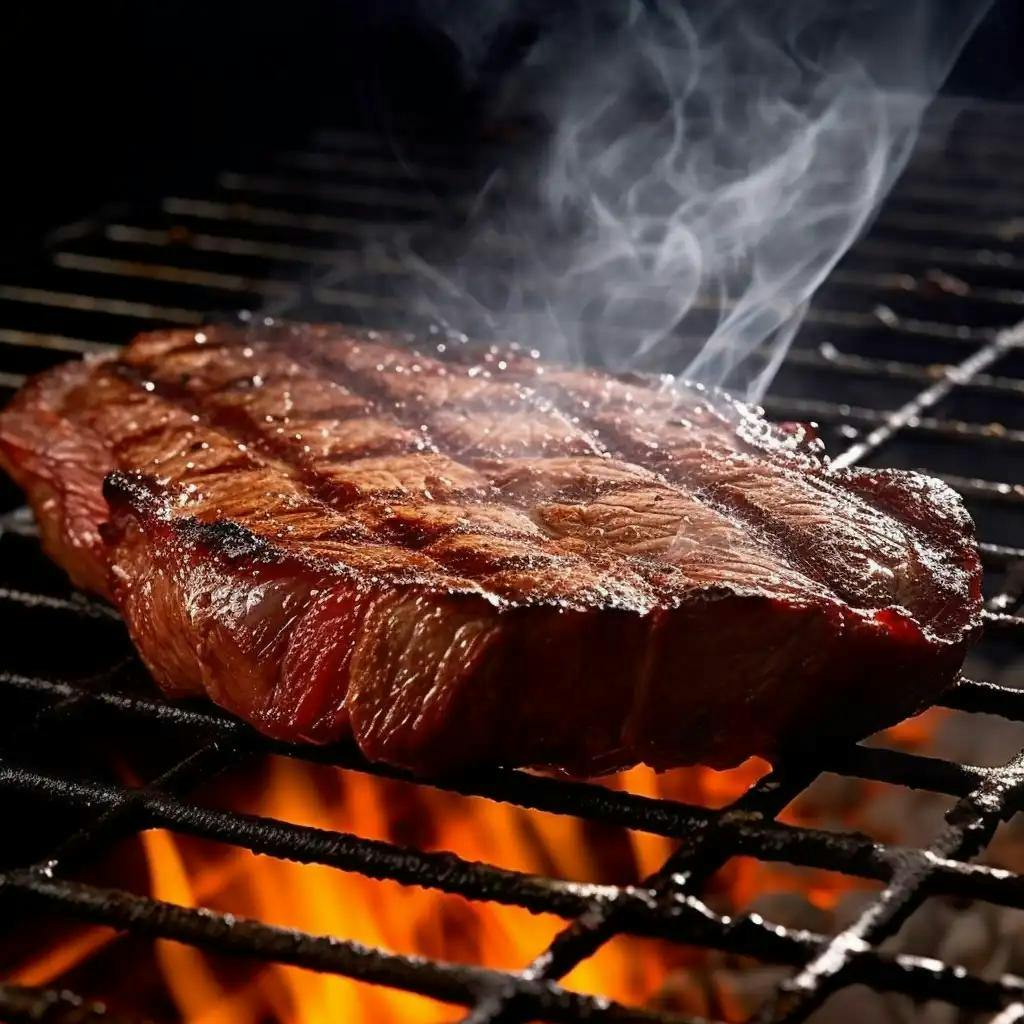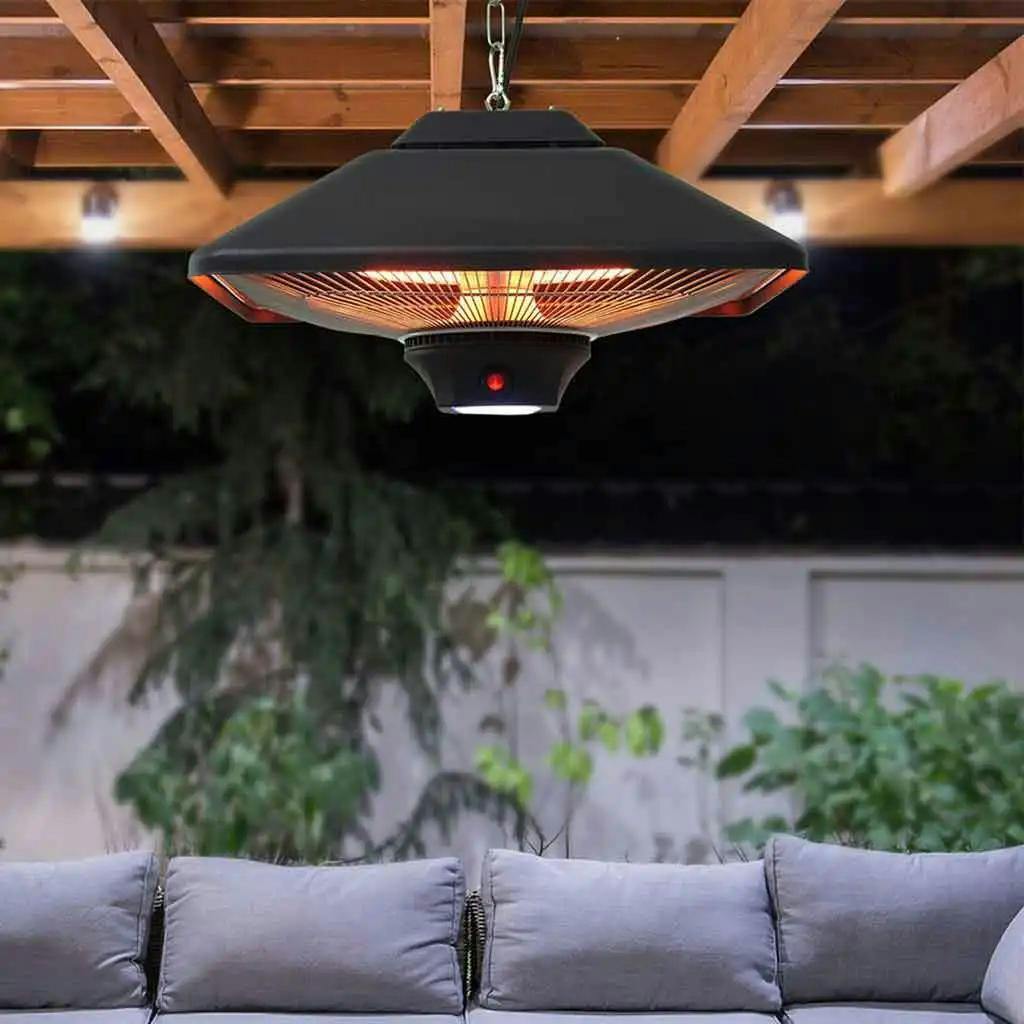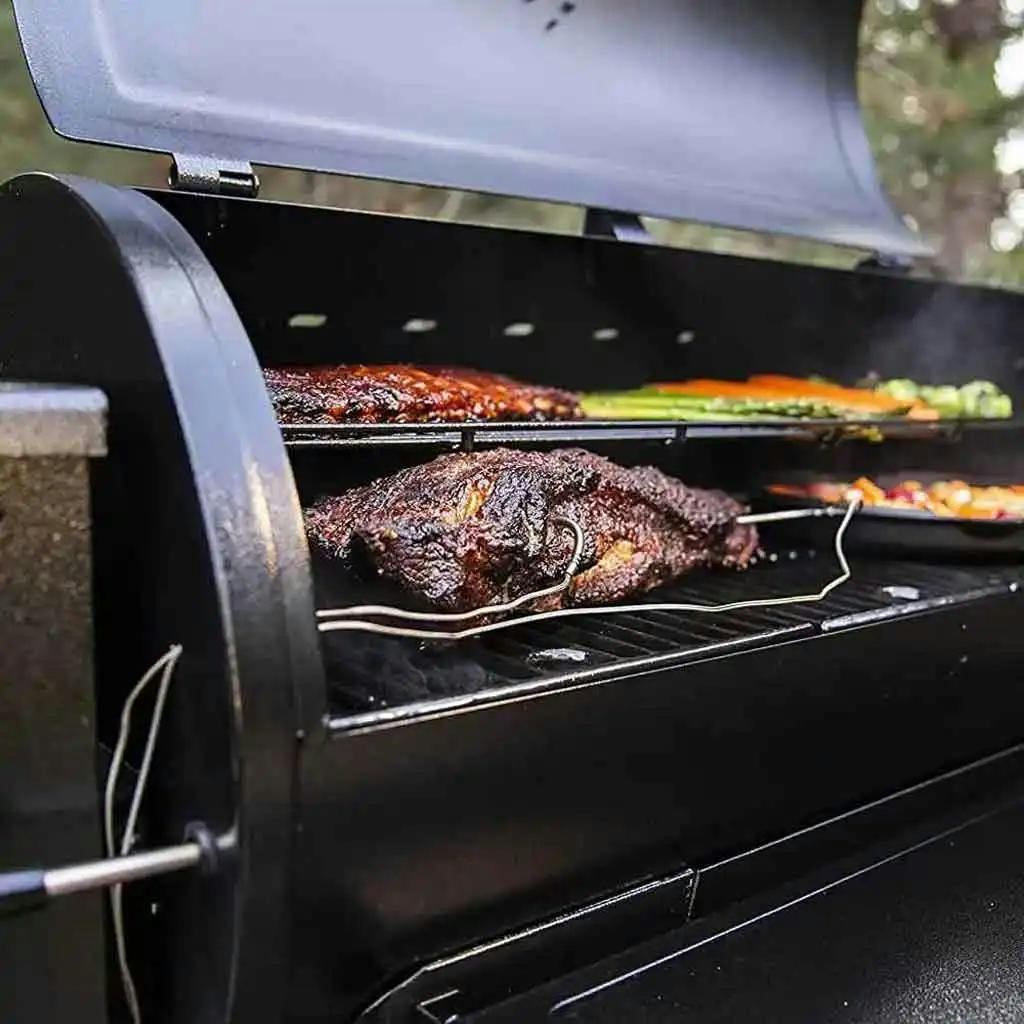When it comes to barbecue, smoking meat is an art form. The slow and low cooking process infuses the meat with delicious smoky flavors, creating a mouthwatering experience that is hard to resist. But how much smoke is too much when it comes to smoking meat? To answer this question, let's first understand the science behind smoking meat and the influence of smoke on flavor.
Smoking meat involves cooking it over indirect heat with the addition of wood smoke. The smoke not only adds flavor but also helps preserve the meat and gives it that coveted pink smoke ring. The smoke is made up of various compounds, including volatile organic compounds (VOCs) and aromatic hydrocarbons, which contribute to the distinct smoky flavor.
Part 1: The Art of Controlling Smoke for Smoking Meat
Controlling the amount of smoke is crucial when smoking meat. While smoke adds flavor, too much of it can overpower the taste of the meat and lead to an unpleasant experience. Additionally, excessive smoke can also have health implications, as some compounds in the smoke can be harmful when consumed in large quantities.
Over-smoking your meat can result in a bitter and acrid taste, leaving you with a disappointing meal. To avoid this, it's essential to find the right balance and smoke level that enhances the flavor of the meat without overwhelming it.
Breaking Down the Smoke Spectrum
Determining the ideal smoke level can be a bit perplexing, as it depends on personal preference and the type of meat being smoked. However, there are a few signs to look out for to identify excessive smoke. If the smoke appears thick and billowy, with a dark color, it's a clear indication that you're using too much wood or the fire is not getting enough air. On the other hand, if the smoke is thin and wispy, it means you may need to add more wood for a stronger smoky flavor.
To achieve the perfect smoke level, it's important to keep an eye on the color of the smoke. Thin, pale blue smoke is what you're looking for. This type of smoke indicates that the wood is burning cleanly and will impart a mild and pleasant smoky flavor to your meat.
Now that we understand the importance of controlling smoke, let's take a closer look at three popular products that can help you achieve the perfect smoke level when smoking meat.

Part 2: Smoke Meat with Weber Smokey Mountain Cooker
The Weber Smokey Mountain Cooker is a top choice among barbecue enthusiasts for its excellent smoke control and consistent results. This charcoal smoker is known for its durability and ease of use. Here are some key features and specifications of the Weber Smokey Mountain Cooker:
- Two cooking grates with a total cooking area of 726 square inches
- Premium-grade steel construction for long-lasting performance
- Built-in lid thermometer for accurate temperature monitoring
- Adjustable dampers for precise control of airflow and smoke level
When it comes to smoke control, the Weber Smokey Mountain Cooker shines. The adjustable dampers allow you to regulate the airflow and maintain the perfect smoke level throughout the cooking process. Whether you're smoking ribs, brisket, or chicken, this smoker provides consistent and delicious results.
Smoking Meat with Weber Smokey Mountain Cooker
Using the Weber Smokey Mountain Cooker is a breeze. Here's a step-by-step guide to smoking meat with this fantastic smoker:
Step 1: Start by filling the charcoal chamber with briquettes or lump charcoal. Light them using a chimney starter, and once they are hot and ashy, spread them evenly in the chamber.
Step 2: Add a handful of wood chunks or chips to the charcoal for the desired smoky flavor. Remember to choose the right type of wood that complements the meat you're smoking accordingly.
Step 3: Place a drip pan filled with water or your favorite liquid (such as apple juice or beer) on the lower cooking grate. This helps keep the meat moist and prevents flare-ups. Arrange the meat on the upper cooking grate, ensuring there is enough space between each piece for proper airflow.
Step 4: Close the lid and adjust the dampers to achieve the ideal smoke level. Start with the dampers fully open and gradually close them as needed. Monitor the temperature using the built-in thermometer and make adjustments to the dampers accordingly. Aim for a cooking temperature between 225°F and 250°F for most meats.
Step 5: Maintain the smoke level by adding more wood chunks or chips as necessary. Cook the meat low and slow until it reaches the desired internal temperature. Use a meat thermometer for accurate readings.
Step 6: Once the meat is cooked, remove it from the smoker and let it rest for a few minutes before serving. When it comes to smoking meat, the Weber Smokey Mountain Cooker delivers exceptional results. The precise smoke control and ease of use make it a must-have for any barbecue enthusiast.
Part 3: Smoke Meat with Masterbuilt Digital Electric Smoker
If you prefer the convenience of an electric smoker, the Masterbuilt Digital Electric Smoker is an excellent choice. This smoker offers precise temperature control and hassle-free operation, making it ideal for beginners and seasoned smokers alike. Here's an overview of its features and specifications:
- Digital control panel for easy temperature and time adjustments
- Four chrome-coated smoking racks for ample cooking space
- Integrated thermostat temperature control for consistent results
- Patented side wood chip loading system for convenient replenishment of wood chips
When it comes to smoke control, the Masterbuilt Digital Electric Smoker provides a user-friendly experience. The integrated thermostat temperature control ensures that the smoker maintains a consistent temperature, resulting in a controlled smoke level. The patented side wood chip loading system allows you to add wood chips without opening the smoker's door, minimizing heat loss and maintaining steady smoke production.
Smoking Meat with Masterbuilt Digital Electric Smoker
Here's a step-by-step guide to smoking meat with the Masterbuilt Digital Electric Smoker:
Step 1: Preheat the smoker to the desired temperature using the digital control panel. Aim for a temperature between 225°F and 275°F, depending on the meat you're smoking.
Step 2: Fill the wood chip tray with your preferred wood chips. Remember to soak them in water for about 30 minutes before use. Place the meat on the smoking racks, leaving enough space between each piece for proper smoke circulation.
Step 3: Close the door, ensuring a tight seal. Set the cooking time and temperature using the digital control panel. Monitor the smoke level and adjust it by adding more wood chips as needed through the side wood chip loading system.
Step 4: Let the smoker work its magic, periodically checking the meat's internal temperature using a meat thermometer. Once the meat reaches the desired temperature, remove it from the smoker and allow it to rest for a few minutes before serving.
The Masterbuilt Digital Electric Smoker offers convenience and excellent smoke control, making it a great choice for those who want to achieve delicious smoky flavors with minimal effort.
Part 4: Smoke Meat with Traeger Pellet Grill
If you're looking for a versatile smoker that combines the convenience of an electric smoker with the authentic flavor of wood-fired cooking, the Traeger Pellet Grill is worth considering. This grill uses hardwood pellets to generate smoke, giving your meat a rich and robust flavor. Here are some key features and specifications of the Traeger Pellet Grill:
- Digital controller for precise temperature control
- Large cooking surface with multiple racks for versatility
- Hopper capacity to hold a substantial amount of wood pellets
- Convection cooking system for even heat distribution
When it comes to smoke control, the Traeger Pellet Grill offers a unique experience. The digital controller allows you to set the desired temperature, and the grill automatically feeds the wood pellets into the firepot to maintain a consistent heat and smoke level. This ensures that your meat gets just the right amount of smoky flavor.
Smoking Meat with Traeger Pellet Grill
Here's a step-by-step guide to smoking meat with the Traeger Pellet Grill:
Step 1: Fill the hopper with your preferred hardwood pellets. Traeger offers a wide variety of flavors to choose from, such as hickory, mesquite, apple, and cherry. Preheat the grill to the desired temperature using the digital controller. Traeger grills typically have a temperature range of 180°F to 450°F.
Step 2: Place the meat on the cooking grates, arranging it to allow proper airflow and even cooking. Close the lid and let the grill work its magic. The convection cooking system ensures even heat distribution and smoke circulation.
Step 3: Monitor the smoke level and temperature using the digital controller. Adjust the temperature as needed. Let the meat smoke until it reaches the desired internal temperature. Use a meat thermometer to ensure accurate readings.
Step 4: Once the meat is cooked, remove it from the grill and let it rest for a few minutes before serving.
The Traeger Pellet Grill offers the best of both worlds – the convenience of an electric smoker and the authentic taste of wood-fired cooking. With precise temperature control and a wide range of flavors to choose from, it's a great option for those who want to elevate their smoking game.
Part 5: Detriments of Excessive Smoke
While smoke adds flavor to your meat, excessive smoke can have some detriments. Over-smoking your meat can result in a bitter and acrid taste, overpowering the natural flavors of the meat. Additionally, some compounds in the smoke, such as polycyclic aromatic hydrocarbons (PAHs) and heterocyclic amines (HCAs), can be harmful when consumed in large quantities.
PAHs are formed when fat drips onto the heat source and causes flare-ups, resulting in black, charred areas on the meat. These compounds have been linked to an increased risk of cancer. HCAs, on the other hand, are formed when meat is cooked at high temperatures, such as grilling or smoking. These compounds have also been associated with an increased risk of cancer.
To minimize the health risks associated with excessive smoke, it's essential to control the smoke level and avoid charring the meat. By maintaining the right balance and following safe cooking practices, you can enjoy the flavors of smoked meat without compromising your health.
Expert Tips to Control Smoke During BBQ
Controlling the smoke level during BBQ requires a combination of techniques and attention to detail. Here are some expert tips to help you achieve the perfect smoke level:
Choose the right wood: Different types of wood impart different flavors to your meat. Experiment with various wood types, such as hickory, mesquite, apple, or cherry, to find your preferred flavor profile.
Soak your wood chips: Soaking wood chips in water before adding them to the fire can help control the smoke level. Wet chips produce less smoke and smolder instead of burning, resulting in a milder smoky flavor.
Use a smoke box or foil pouch: If you're using a gas or electric grill, using a smoke box or foil pouch for your wood chips can help control the smoke level. These containers hold the wood chips and prevent them from burning too quickly.
Adjust the vents: Most smokers and grills have vents or dampers that allow you to control the airflow. Opening the vents allows more oxygen to reach the fire, resulting in a hotter fire and more smoke. Closing the vents restricts the airflow, reducing the smoke level.
Monitor the temperature: Keeping a close eye on the temperature inside your smoker or grill is crucial. Too high of a temperature can cause excessive smoke, while too low of a temperature can result in inadequate smoke production. Use a reliable thermometer to ensure accuracy.
By following these expert tips, you can have better control over the smoke level during your BBQ sessions and achieve the perfect balance of flavor.
Mistakes to Avoid When Smoking Meat
While smoking meat can be a rewarding experience, it's not without its challenges. Here are some common mistakes to avoid when smoking meat:
Using too much wood: Using an excessive amount of wood can lead to an overpowering smoke flavor and a bitter taste. Start with a small amount of wood and adjust as needed.
Ignoring the fire: Keeping a close eye on the fire is crucial when smoking meat. Ensure that the fire is getting enough oxygen and maintain a steady temperature throughout the cooking process.
Rushing the process: Smoking meat is a slow and low cooking method. Patience is key to achieving tender and flavorful results. Avoid rushing the process by increasing the heat or opening the smoker frequently.
Overcrowding the smoker: Overcrowding the smoker can hinder proper smoke circulation and result in uneven cooking. Leave enough space between each piece of meat to ensure even heat distribution.
Neglecting the meat's internal temperature: Relying solely on cooking time can lead to overcooked or undercooked meat. Always use a meat thermometer to check the internal temperature and ensure it reaches the desired doneness.
By avoiding these common mistakes, you can improve your smoking skills and create mouthwatering barbecue dishes that will impress your friends and family.
Part 6: Considerations When Investing in a BBQ Smoker
When it comes to investing in a BBQ smoker, there are several factors to consider. Here are some key considerations to keep in mind:
Type of smoker: There are various types of smokers available, including charcoal, electric, pellet, and gas. Each type has its pros and cons, so choose the one that best suits your needs and preferences.
Size and cooking capacity: Consider how much food you plan to smoke at once. Smokers come in different sizes, so choose one that can accommodate your desired cooking capacity.
Temperature control: Look for a smoker that offers precise temperature control. Maintaining a consistent temperature is crucial for achieving the perfect smoke level.
Smoke control features: Some smokers have built-in features that help control the smoke level, such as adjustable dampers or digital controllers. These features can make the smoking process easier and more enjoyable.
Build quality and durability: A BBQ smoker is an investment, so choose one that is built to last. Look for smokers made from high-quality materials that can withstand the test of time.
Ease of use and cleaning: Consider the ease of use and cleaning when selecting a smoker. Look for features such as removable grates and ash pans that make cleaning a breeze.
Budget: Set a budget for your BBQ smoker and stick to it. There are smokers available at various price points, so you're sure to find one that fits your budget without compromising quality.
By considering these factors, you can make an informed decision and find the perfect BBQ smoker that meets your specific needs and preferences.
Is There Such a Thing as Too Much Smoke?
When it comes to smoking meat, finding the right smoke level is crucial. Too much smoke can overpower the flavor of the meat and result in an unpleasant taste. On the other hand, too little smoke can leave you craving that delicious smoky flavor.
The ideal smoke level is achieved when the smoke appears thin and pale blue. This type of smoke imparts a mild and pleasant smoky flavor to your meat without overwhelming it. It's important to monitor the smoke level throughout the cooking process and make adjustments as needed.
By using the right smoker, following expert tips, and avoiding common mistakes, you can achieve the perfect balance of smoke and flavor in your barbecue dishes.
Conclusion
Smoking meat is a culinary adventure that allows you to explore different flavors and create mouthwatering dishes. With the right smoker and proper smoke control techniques, you can elevate your barbecue game and impress your friends and family with delicious smoky flavors.
Remember to choose the right wood, monitor the smoke level, and consider the health implications of excessive smoke. By following expert tips and avoiding common mistakes, you can master the art of smoking meat and achieve the perfect smoky flavor every time. So fire up your smoker, gather your favorite meats, and embark on a smoky journey that will leave you craving more.
FAQs
How do I know if I'm using too much smoke when smoking meat?
Excessive smoke is usually thick and billowy, with a dark color. If you notice this type of smoke, it's a clear indication that you're using too much wood, or the fire is not getting enough air. Thin, pale blue smoke is what you're aiming for.
Can excessive smoke affect the taste of the meat?
Yes, over-smoking your meat can result in a bitter and acrid taste, overpowering the natural flavors of the meat. It's important to find the right balance and smoke level to enhance the flavor without overwhelming it.
Are there health risks associated with excessive smoke?
Some compounds in the smoke, such as polycyclic aromatic hydrocarbons (PAHs) and heterocyclic amines (HCAs), can be harmful when consumed in large quantities. PAHs are formed when fat drips onto the heat source and causes flare-ups, while HCAs are formed when meat is cooked at high temperatures. It's important to control the smoke level and avoid charring the meat to minimize these health risks.
How can I control the smoke level when smoking meat?
There are several techniques to control the smoke level, such as choosing the right wood, soaking wood chips, adjusting vents or dampers, and monitoring the temperature. These techniques help regulate the airflow and maintain the ideal smoke level throughout the cooking process.
What type of smoker is best for smoke control?
Different types of smokers offer varying degrees of smoke control. Charcoal smokers, such as the Weber Smokey Mountain Cooker, allow for precise control of the smoke level through adjustable dampers. Electric smokers, like the Masterbuilt Digital Electric Smoker, offer convenience and consistent results. Pellet grills, such as the Traeger Pellet Grill, provide a unique wood-fired flavor with automated temperature and smoke control. The best smoker for you depends on your personal preferences and needs.
About Marianne Williamson
Marianne Williamson, a Texan, finds BBQ a mindful journey of connection. The grill isn't just about cooking—it's a way to relish the moment and create memories. With the sun's warmth and the sizzle, grilling becomes an exploration, from marinades to searing. Join her in celebrating life's flavors and joys around the grill.

![Master the Art of Lighting Patio Heaters Manually [2023 Guide]](/_next/image?url=https%3A%2F%2Fcdn.sanity.io%2Fimages%2F8ngmz6db%2Fproduction%2F74752d01c9dddeee7530856cb05237f6169be0c9-1024x1024.webp%3Fw%3D1024%26auto%3Dformat&w=3840&q=75)

